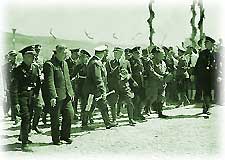Summary
Kurt Tweraser

The author sums up the various contributions in six principal themes.
1. National Socialism in power cannot be understood without a perspective which reaches back into its antecedent years and goes beyond the years 1938-1945 to take account of its consequences.
2. The analysis of a city or a region must aim at a better understanding of its embeddedness in the larger history of the times. Local history cannot be written properly without a macrohistorical framework. This is especially valid for wartime when the destructive dynamics of National Socialism raged both outside and inside the Third Reich.
3. Central for a regional history, too, is the all-pervasive racist dimension of National Socialist politics. National Socialist social and economic planning and execution had a racial dimension. Racialism was the fixpoint of the regime whose persecution, exclusion and murder of human beings in an ever-increasing radicalization in the name of a racialist utopia, culminated in the genocide of Jews, Sinti and Roma and the ethnocide of Poles and Russians.
4. The Third Reich was neither a pure “Fuehrer State” nor a pure polycracy. Rather it was the dialectic relationship between the centralist and middle levels of power, which leads to an understanding of the power structure of the regime. In this context the role of the “Gau leaders” becomes prominent. Their key to power was access to Hitler and their power increased with the prolongation and radicalization of the war. Just as Hitler was the monocratic center in a polycratic middle structure, the multifunctional “Gau leader” held a grip on power at the substructures of power. The City of Linz was directly affected by this configuration, since the concentration of power in the “Gauleiter” made independent communal policy largely impossible.
5. Resistance and persecution are themes essential for grasping the essence of the NS-regime. An evaluation of the resistent attitude of various sectors of society is, therefore, necessary, especially of the most potent of them, the Catholic Church. In the realm of persecution, the exploitation of foreign workers, Jews and KZ inmates has become ever more relevant recently. Forced labor was the object of a permanent conflict between economic interests, whose priority was efficiency, and SS-organizations, whose priority was the upholding of “racial purity”.
6. A question running through the whole book concerns the “modernizing” effects of the NS-regime. Without a doubt, the modernization which characterized the 1950's in Austria, and particularly in Linz and Upper Austria, was partially grounded in the economic changes induced by the NS-regime. However, attempts to deduce therefrom any progressiveness of the NS-regime must be rejected. Too close is the connection between the socalled “positive” sides of National Socialism in its social and economic policies and its ever-increasing action-relevant racialism.